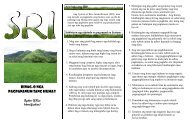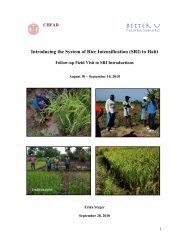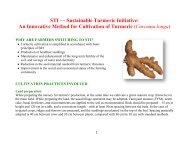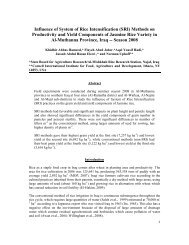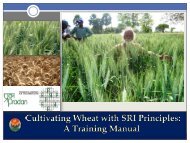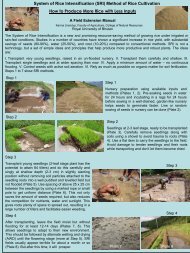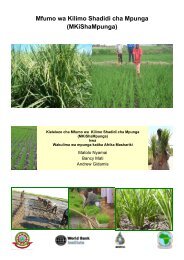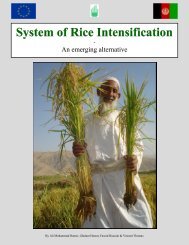EFFECT OF THE SYSTEM OF RICE INTENSIFICATION (SRI) ON ...
EFFECT OF THE SYSTEM OF RICE INTENSIFICATION (SRI) ON ...
EFFECT OF THE SYSTEM OF RICE INTENSIFICATION (SRI) ON ...
Create successful ePaper yourself
Turn your PDF publications into a flip-book with our unique Google optimized e-Paper software.
Table 1. The major differences between <strong>SRI</strong> and conventional rice production methods. Taken from Stoop et al.<br />
(2002).<br />
There are however large disputes concerning <strong>SRI</strong> and its successes with farmers as there are many<br />
pros and cons. Supporters claim that <strong>SRI</strong> often yield the double of conventional rice farming, but<br />
opponents state that there is no scientific evidence for such potentials (Surridge, 2004). There are<br />
however many experiments which illustrate the benefits of <strong>SRI</strong> and those that illustrates that there is<br />
no difference between <strong>SRI</strong> and conventional rice growing. Very high yields have been reported<br />
with <strong>SRI</strong> as compared to traditional farming or farmers practice. Table 2 below illustrates some of<br />
the reported high yielding situations from rice growing countries.<br />
Table 2. <strong>SRI</strong> vs. farmer practice yields.<br />
<strong>SRI</strong> (t/ha) Conventional - Farmer Practice (t/ha) Specifications Country Reference<br />
7,4 2,5 N = 10 Gambia Caesay (2002)<br />
5,3 2,5<br />
N = 8 groups of 20<br />
farmers.<br />
Sierre Leone Yamah (2002)<br />
7-15 Madagascar Stoop et al., (2002)<br />
6,5 2,08 Myanmar Kabir & Uphoff (2007)<br />
2.3 1,6 N = 500 Cambodia Anthofer (2004)<br />
Such yields as described above are though according Dobermann (2004) not scientifically reliable<br />
and non comparable to conventional rice growing. Dobermann (2004) further states that in many<br />
experiments where <strong>SRI</strong> is compared to conventional farming a scientific methodology has not been<br />
followed and it is therefore very difficult to compare the two systems. McDonald et al., (2006)<br />
compared and compiled data from yields between <strong>SRI</strong> and conventional rice growing in China,<br />
Laos, Nepal, Thailand, India, Sri Lanka, Indonesia, Bangladesh, and the Philippines and found that<br />
in a majority of these countries <strong>SRI</strong> provided lower yields than conventional growing. Sheehy et al.<br />
(2004) compared <strong>SRI</strong> with conventional grown rice at three sites in China regarding grain yield,<br />
number of panicles, spikelets per panicle, grain filling and grain weight and found no difference<br />
between the two methods. Sheehy et al. (2004) further states that the very high reported yields from<br />
Madagascar are not possible and are due to measurement errors.<br />
25



